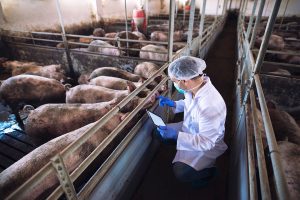Hog output to rise 3% this year as vaccine approvals loom

HOG production may increase by 3% this year as farmers continue to grapple with the effects of the African Swine Fever (ASF) outbreak, farmers said.
“Right now we are at 18 to 19 million head, but this is far from pre- ASF. We (will have) a 3% increase this year… even despite problems in the (industry)” National Federation of Hog Farmers, Inc. President Chester Warren Y. Tan said on the sidelines of a hog industry event last week.
Hog production rose 3.3% in 2023, with volumes hitting 1.79 million metric tons, according to the Philippine Statistics Authority (PSA).
Mr. Tan said the hog population was up from 13 million head in 2022.
“We are still positive of an increase in production,” he added.
Separately, Agriculture Secretary Francisco P. Tiu Laurel, Jr. said that an ASF vaccine will likely be approved this year after two suppliers submitted applications to the Food and Drug Administration (FDA).
“There are vaccines that are on their way to being accredited… I hope if they are accredited this year, then we can slowly eradicate ASF by next year,” Mr. Tiu Laurel told reporters.
He said that a US and Vietnamese supplier are currently seeking approval from the FDA. Other companies from Vietnam and Thailand are also planning to apply.
Until a vaccine is approved, the Department of Agriculture (DA) is prescribing heightened biosecurity measures to slow the spread of ASF.
According to the Bureau of Animal Industry, 12 provinces have active ASF cases as of Feb. 20, with red zone measures in place.
Towns are classified as red zones if an outbreak is detected in a single barangay, with hog movements restricted. The mobility restrictions ramp up with outbreaks in two or more barangays.
The DA reimburses farmers P5,000 for each culled hog, up to a limit of 20 head.
The first ASF case in the Philippines was detected in 2019. To date, a total of 73 provinces have been hit by ASF since 2019. — Adrian H. Halili




